What are LED lamps for the home. How to choose LED for home. What to pay attention to
The main advantage of LED light sources is significant energy savings. You can get tangible and desired results using the products of the Svetovoy online store.
Already familiar to many energy-saving fluorescent lamps are gradually fading away. It is being replaced by lighting equipment of a fundamentally new type, with different light and quality characteristics. Modern LED light sources have a whole range of advantages over their predecessors. This applies to light output, energy consumption, service life, environmental friendliness, fire and mechanical safety. The "minuses" that make their implementation difficult include the higher cost and the conservatism of a certain part of the population.
To overcome doubts, it is enough to turn to table of correspondence of power of LED lamps characteristics of light sources of the previous generation.
Table comparing characteristics of lamps: incandescent, halogen, energy-saving fluorescent and energy-saving LED lamps
The table of correspondence between the luminous efficiency of energy-saving (fluorescent) lamps and incandescent lamps corresponds to
LED and Incandescent
It should be noted that the table figures are averages and may differ for specific products. However, the conclusions are clear. Traditional, but obsolete, uneconomical light bulbs lose significantly. The given table of correspondence of the power of LED lamps, even taking into account the inevitable error, convincingly proves the advantages of the new generation systems. To this must be added a long service life, due to their design features and providing a quick and repeated payback. Analysis of tabular data, simple calculations show: the present and the future are behind the LEDs!
On LED bulbs and lamps are being switched by those who are looking for new ways to save money, since replacing conventional incandescent lamps, both for indoor and outdoor, brings, according to manufacturers of LED products, a significant reduction in energy costs.
The content of the article about the power ratio of LED lamps
LED lamps can help with this problem, but they should not be used thoughtlessly. Let's try to understand the reasonableness and expediency of using LED lamps to replace other lighting sources in various fields applications.
Compliance with the power of LED lamps and incandescent lamps
What you need to know when installing LED lamps for street lighting
High power LED lamps
The type of lamps that has received the widest distribution, which is used for - is DRL with a power of 250 watts. To replace it with a more economical option in the form of an LED lamp, you need to choose lamps that have an E40 base, as well as about 30 super-bright LEDs. Their electricity needs are about 30 watts. For example, POWERLEDS brand E40 LED lamps are equipped with 28 ultra-bright LEDs at a consumption of 30 watts.
As a result, by properly matching the wattage ratio of LED bulbs to those you are replacing, you can save up to 12 times your energy bill!
Power ratio of economical LED lamps
Next, let's take a look at our comparison of the most economical LED lamps that can be used as replacements for MR16 and GU10 halogen lamps. The 50-watt "halogens" can be replaced by LED lamps, which have three super-bright one-watt LEDs. As a result, the power consumption when installing such a lamp can be about 3-4 watts, but the savings in this case can reach up to 12.5 times.
Choosing an LED lamp for indoor lighting
Conventional incandescent lamps can be replaced with LED counterparts, which also represent an excellent potential source of energy savings. This type of lamp is produced in various versions and modifications, including in the form of a "ball", "candle", "candles in the wind", "pears" and many others. There are several dozens of ball-shaped LED lamps on the market today, ranging from the most low-power (3 W) that can replace 40-watt incandescent lamps to heavy-duty 12-watt and more, which are used in the industrial sector.
The power ratio of a 100-watt incandescent lamp to LED
Potential savings can be calculated by comparing 100-watt incandescent bulbs to their LED equivalents. For example, let's take LED lamps with an E27 base, which can emit a luminous flux from 270 to 290 lm or more powerful versions with 600 lm. However, they consume only 3.2 watts. When comparing 100 and 3.2 W, the energy saving is almost 31.3 times!
Let's also do a power ratio when replacing their fluorescent counterparts. Ceiling with four such lamps of 18 W each consumes 72 watts. However, if we install their analogues, 8 W LED lamps, in the same luminaire, then the electricity consumption will be only 32 W, which indicates a saving of 2.25 times.
In order to accurately select the LED analogue to replace your incandescent lamps or other light sources, you can use special tables that can be easily found on the Internet.
The expediency of the correct ratio when choosing and installing LED lamps instead of other light sources allows you to achieve maximum energy savings with a fairly comfortable level of illumination for the eyes.
These two factors may outweigh any downsides to LED bulbs, as even regardless of the cost of purchasing them, the savings are still clear.
If you decide to make lighting in the house using LED bulbs, you need to approach their choice correctly. This is primarily due to the fact that products have many parameters that affect electricity savings, lighting comfort, product costs, etc. Among these parameters, the main ones are the luminous flux of products, the angle of dispersion, the manufacturer, the power and the type of base. Next, we will try to consider each of the criteria in as much detail as possible so that you learn how to choose LED lamps for your home and apartment.
Power
The first and probably the most important characteristic for buyers is the power of LED bulbs. How many watts the product consumes will determine the efficiency of lighting.
A very important nuance that you must remember is that when replacing with LEDs, the power of the modern version must be reduced by at least 7.5 times. In simple words- if a 75 W light bulb was screwed in, the LED should be selected with a power of no more than 10 W.
You can see the difference in the comparison table:

As you can see, even with the example of replacing one light source, the savings are huge. But what if you replace the entire apartment? For houses and apartments, it is better to choose LED lamps with a power of 6 to 8 W, which illuminate the room with better quality than 60-watt incandescent lamps.
Immediately I would like to say a few words about another important parameter - voltage. There are light bulbs operating from 12 and 220 V. The first option is used in rooms with high humidity, for example, during installation. You should not buy 12-volt products with the expectation that they will consume less electricity, because. this is not true.
Video comparison of LED and fluorescent lamps
The next option to choose wisely is . As you can see in the picture, the higher the temperature (in Kelvin), the colder the glow will be. 
For a comfortable time in the room, you do not need to choose LED lamps with bright daylight which are most often used in offices and industrial premises. It is better to give preference to the range from 2700 to 3000 K, because. this temperature gap is a yellowish glow of the usual sunlight. The packaging may indicate the color in word form. Buy those models that are signed as "warm white" or "soft white".
Plinth type
We have already talked with you in detail about where the most popular product designs were provided. When choosing LED lamps according to the type of base, it is better to dwell on the option that was previously. For example, if a standard E27 threaded base was screwed into the chandelier, look on the market for an LED with the same thread.

If you decide, you need to choose a LED lamp with a GU 5.3 base. Sconces and nightlights use E27 and E14 (Mignon) threads. The shape of the light sources can be very diverse: pear-shaped, elongated, round. Here already give preference to your taste and design of the lamp.
The presence of a radiator
The heat sink removes the temperature from the LED block. If the design does not provide for a cooling system in the form of an aluminum finned surface, bypass such a model.

Sometimes manufacturers of cheap products install a radiator in the form of a plastic outlet. We do not recommend you to choose this option, because. plastic has many drawbacks and, compared to aluminum, it does not have such a high cooling efficiency. On this occasion, you can see a lot of negative feedback on the forums from those people who took advantage of this option.
It should also be noted here that frosted flasks do not allow you to see whether a radiator is installed or not, so when choosing LED lamps for your home and apartment, think about whether you need opaque bulbs. 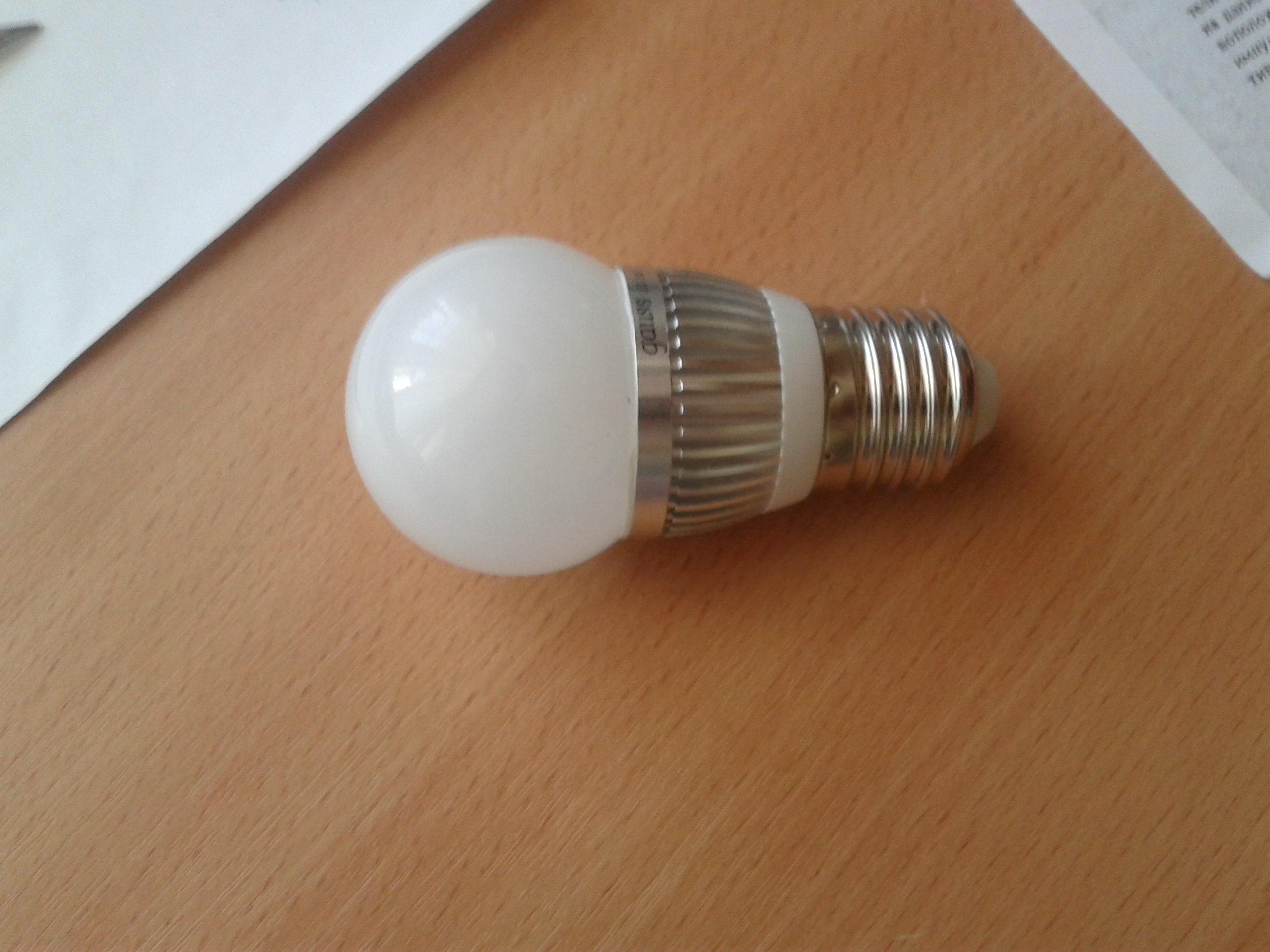
By the way, you can understand whether there is a radiator in the LED lamp by weight. If the light bulb is heavy (it differs in weight from analogues), most likely it has a high-quality aluminum radiator. This design option can be chosen without a doubt for an apartment or a house.
Also when choosing LED lamps pay attention to such a characteristic as a working resource. To date, this figure may exceed the bar of 50 thousand hours, which is about 15 years of work. At the same time, we do not recommend too much relying on the reliability of information. The fact is that over time it happens and the quality of their glow noticeably decreases. 
It will be better to start not from the working resource, but from the warranty period of operation. This time can be from 3 to 5 years, which means the following - if the light bulb fails during this period of time, it will be changed to a new one for free. Actually a useful thing, but the problem is that domestic and not very high-quality firms allow a warranty period of up to 3 years (foreign ones from 5). As a rule, during these 3 years, breakdowns are extremely rare.
This parameter must also be taken into account when choosing LED bulbs for the home. The nature of the illumination will depend on whether a diverging lens is installed and whether it is coated on the inside with a phosphor. 
Also pay attention to how the LEDs are positioned. If they are all in the same plane, the light will be narrowly focused. At the same time, the multi-level placement of diodes will create diffused lighting. 
Color Ratio
Few people pay attention to this when choosing them, but, nevertheless, it is also important. For bright lighting, the color transfer coefficient must be at least 80. A value of 95 is considered a high indicator, but such a model will be much more expensive at a price. The color rendition is indicated on the package, but it is not always possible to find it on the front side.
Here I would like to tell you a little trick. You can check how high-quality the manufacturer of the light bulb you have chosen is by this coefficient. If the lamp is cheap and the value on the package is high, then it is a fake.
Dimmer compatible
When we examined, we paid attention to the fact that not all models of dimmers can be used with ice lamps. The LEDs for connecting to the dimmer must be specially designed, this must be indicated on the packaging. 
If you choose an LED lamp that does not work with a dimmer, both the dimmer and the bulbs will quickly fail. You can learn more about it in our related article!
Appearance of the package
The packaging itself says a lot about the quality of the light bulb. 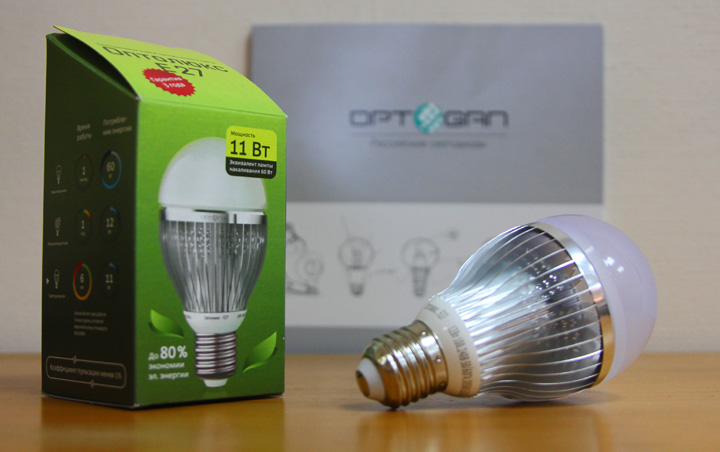 As a rule, the following elements are displayed on the packaging of the popular ones:
As a rule, the following elements are displayed on the packaging of the popular ones:
- information about the manufacturer;
- power;
- warranty period of work;
- plinth type;
- luminous flux (indicated in Lumens);
- color rendering coefficient;
- color temperature (both in verbal form and in Kelvin);
- barcode.
If many of these parameters are not specified, the product is unlikely to be of high quality. Also, when choosing LED lamps for home and apartment, we advise you to pay attention to the build quality itself. At good producers all fastening elements are made without gaps, irregularities and roughness.
A visual lesson on packaging review is discussed in detail in this video:
How to determine the quality of an LED lamp
Manufacturers
As you understand, much of the above depends on the manufacturer. As for countries, both domestic and foreign companies produce fairly reliable products. Consider how to choose the right LED lamps by manufacturer. 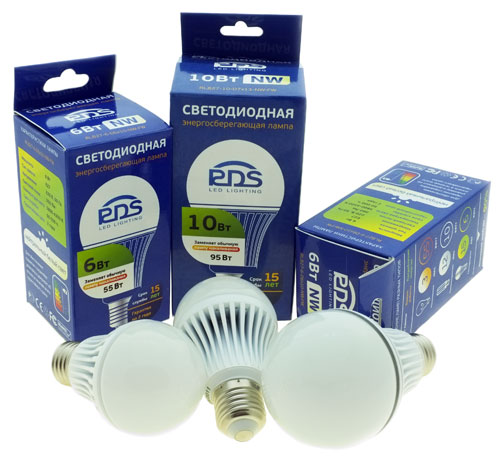
The leaders of the rating are such giants as Osram, Philips, Nichia, CREE and GAUSS. There are a lot of positive reviews about the Chinese company MAXUS, whose products have the highest warranty period at a relatively low price. Among domestic manufacturers, such Russian campaigns as "Svetlana-Optoelectronics" and Optogan (Optogan).
Extra options
In 2017, they are gaining more and more popularity, which have such functionality:
- Protection from thieves. The light bulb remembers the time of turning on and off by the owners for a week and in their absence turns on and off on its own, simulating the effect of presence.
- Has an on and off timer. The settings are set manually.
- Control from the remote control. In addition to turning the light on and off, you can choose the brightness or color of the glow.
- Smoke and motion sensors.
- The presence of a battery. When the light is turned off, the lamp can still work for several hours, which provides.
- Strengthening the Wi-Fi signal. Smart LED lamps can expand the coverage of a Wi-Fi network through built-in antennas. This will strengthen the wireless signal in places where it is very weak.
- The presence of speakers. Yes, the bulbs can even play your favorite music from your smartphone. To do this, you just need to synchronize the lamp and phone via Bluetooth.
The most popular models of LED smart bulbs are Philips Hue, Xiaomi Yeelight LED and Luminous BT Smart Bulb. Want to choose smart led light bulb for an apartment or a house? Take a look at the listed models.
In addition, when choosing LED lamps, pay attention to the operating temperature range. For the street, you need to choose a light bulb that can function at a minimum temperature mark of about -40 ° C. For baths and saunas, on the contrary, the operating temperature of the LEDs should be around +90°C.
Well, the last thing I would like to talk about is the ripple coefficient. If the lamp pulsates, this indicates a low quality rectifier in the power supply. The stronger the pulsation, the faster the person gets tired, and his nervous system is also more excited. Unfortunately, it is impossible to estimate the ripple coefficient with the naked eye. This will require a special device or at least a mobile phone camera. Ask to turn on the light bulb, point the camera at it, if the image starts flashing, then the LED lamp is pulsing, we do not recommend choosing it.
That's all I wanted to tell you about how to choose LED lamps for the home and which models are best for domestic use. We hope that this information was new and useful for you! If you have any questions, our experts will answer them in the comments or category "
LED lamps - a new word in the evolution of lighting equipment. More recently, they were a rare exotic, and now they are firmly entering homes, and it will not be difficult to buy them in any company selling lighting equipment. There is a steady trend towards the fact that LED incandescent lamps will take a leading position in the market in the near future.
The principle of operation of LED lamps
Light emitting diodes have been used in electronic equipment for a long time. It all started with indicator lights, instrument panels, information boards and advertising. The development of technology has made it possible to use LED lamps for lighting. From an incandescent lamp LED design characterized by minimal heating loss during conversion alternating current into permanent. The strength of the glow directly depends on the strength of the current: more current - brighter light. The LED lamp, 220V voltage, is much more economical and safer than many other light sources.
Scheme of the device of the LED lamp
As can be seen from the diagram, the principle of the LED glow is based on the passage through it electric current. A special control device is placed in the device - a microcircuit.  Also, a converter is built into the design, which changes the current of the general electrical network into the operating parameters of the lamp components. The LED lamp (220V) differs from other devices alternative to the incandescent lamp in that its circuit does not contain an energy-intensive part - a transformer. This affects the efficiency of the device. The principle of operation of the LED lamp is the same for all models, regardless of the shape of the ceiling, light and color radiation, power. Differences can only be in the value of the operating voltage. As a rule, these are standard values in 4; 12 and 220 volts.
Also, a converter is built into the design, which changes the current of the general electrical network into the operating parameters of the lamp components. The LED lamp (220V) differs from other devices alternative to the incandescent lamp in that its circuit does not contain an energy-intensive part - a transformer. This affects the efficiency of the device. The principle of operation of the LED lamp is the same for all models, regardless of the shape of the ceiling, light and color radiation, power. Differences can only be in the value of the operating voltage. As a rule, these are standard values in 4; 12 and 220 volts.
Technical features. Economy
The main feature of the characteristics of LED lamps is low consumption of electrical energy, but at the same time, high light output, maximum light flux. The spectrum emitted by lighting devices is determined by the color temperature. This value is usually expressed in degrees Kelvin. The warmer (closer to yellow) the light, the smaller the numerical value.

A familiar, traditional tungsten filament lamp has a color temperature value of 2700 to 3500 K. At the same time, the color temperature of the cool white light emitted by LED fluorescent lamps reaches 6500 K. The low temperature, yellow color is most pleasing to the eye, it is at a minimum blocks the release of melatonin. With this in mind, the industry has begun to produce low color temperature LED lamps using a combination of different LEDs - LED-RGB. However, the price becomes incomparably high.
plinth
Another feature that affects consumer qualities. Modern lighting fixtures and equipment are produced with different cartridges, the socle elements of LED lamps also differ in the same way. They can be pin, pin, soffit, focusing, telephone.  Nevertheless, today the most common in everyday life is the classic model of Edison's threaded base.
Nevertheless, today the most common in everyday life is the classic model of Edison's threaded base.
Heat generation
The characteristics of LED lamps indicate another technical parameter - the heat generated during operation. Its dissipation contributes to the radiator. This is an aluminum, graphite or ceramic part built into the device. In accordance with accepted standards, the operating temperature should not exceed 70 degrees. As a rule, the radiator is protected by a thermoplastic casing.
Variety of choices
LED lamps differ in design. A variety of shapes allows you to choose a model for any type of lighting fixture or interior style. Round, plum-shaped, spherical, standard. In closed shades, lamps with transparent flasks are used that do not hide the internal "stuffing". 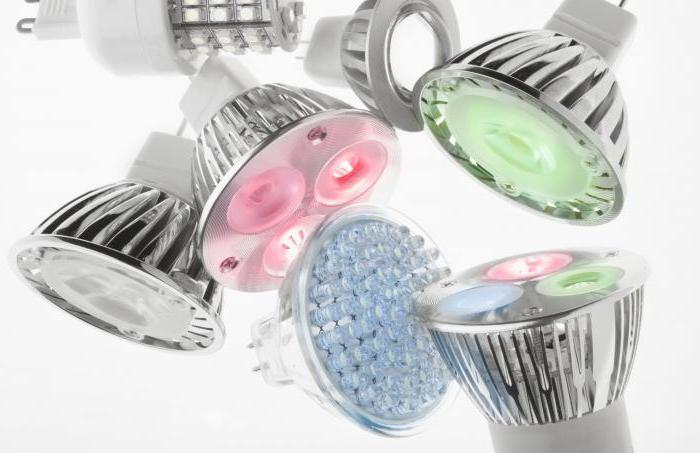 To create an aesthetic, design effect, a matte finish is indispensable, giving a soft, uniform light. If directional lighting is required, then a mirror lamp will create it. The most popular LED lamps "candle". They go great with a variety of creating the illusion of light from a burning flame. The design of the flask is very original:
To create an aesthetic, design effect, a matte finish is indispensable, giving a soft, uniform light. If directional lighting is required, then a mirror lamp will create it. The most popular LED lamps "candle". They go great with a variety of creating the illusion of light from a burning flame. The design of the flask is very original:
- "twisted" with a matte finish;
- "twisted" with a golden coating;
- "candle in the wind";
- "a candle with a wick".
The characteristics of LED candle lamps also reflect technical solutions. As a result of the ability to embed lamps in materials such as plastic, silicone and even paraffin, original models have appeared:
- "tea", including floating;
- multicolor;
- controlled remotely - by remote control;
- with USB charging and battery;
- with high imitation of a real flame;
- equipped with a timer.
The heavy burden of choice
Having found out the advantages and disadvantages, how to choose an LED lamp for your home? First of all, you need to pay attention to the power consumption.  For different, these values are not the same. This is shown in the comparison table, the unit is watt:
For different, these values are not the same. This is shown in the comparison table, the unit is watt:
When lamps are replaced with LEDs, this parameter can be calculated by simply multiplying the power value by 6 LED fixture. You also need to pay attention to the marking of the base. It must match the type of cartridge. So, a lamp with the designation G9 can only be installed in a G9 socket. The coupling of the base with the flask must be strong, excluding loosening. If there are backlit switches in the electrical network, then it is not recommended to complete it with LED lamps.
How to choose an LED lamp for a home that uses dimmer devices? Most lamps do not respond to dimmer control, but turn on and work continuously. But gradually the market is saturated. A specially assembled driver allows, by means of a dimmer, to adjust the brightness of the lamp. This property is marked with the appropriate marking on the lamp or packaging.
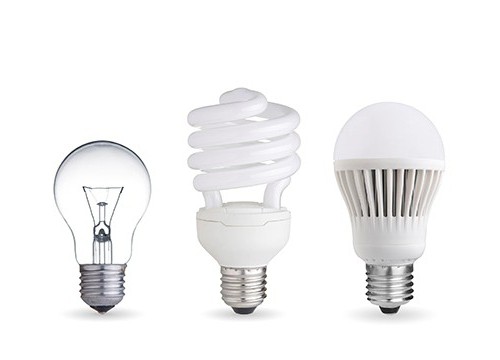
Lamp selection may be affected by the manufacturer's specified lifetime. Usually declared from 20 to 50 thousand hours. But practice does not confirm these figures. There is a direct dependence of the durability of the device on the quality factor of the components and the thoroughness of the assembly. Low-quality Chinese consumer goods break down in a matter of months. Well-known brands guarantee normal work lamps for 3-5 years. This is due to the process of degradation of crystals, they slowly lose their brightness and completely stop glowing.
Another way to choose an LED lamp for your home is to evaluate the spectrum of its glow. Most lamps emit an unpleasant, lifeless white light. According to psychologists, it negatively affects well-being. In the home interior, you should purchase LED lamps of a soft yellow glow.
Poor build quality causes radiation ripple. Such a flaw is not noticed by the human eye, but it strongly affects the nervous system, provoking rapid fatigue. The presence of such a defect can be established using a mobile phone, its camera. The flashing lamp image on the screen will flash.
Manufacturer and price
How to choose LED lamp for home? Price is an important criterion. Low cost lighting device, undoubtedly indicates the poor characteristics of the purchased product. Quality products cannot be cheap. This applies to well-known foreign brands. There is an opinion among consumers that the most high-quality and reliable LEDs are imported from abroad. This is not entirely true, if you understand in detail and analyze the modern lighting market, you can come to the conclusion that individual Russian companies demonstrate high quality and stability of their products. Domestic manufacturers have made a big step forward and their products are also trustworthy.
LED lamps are considered an environmentally friendly light source. Skillfully selected lighting allows you to create a functional interior and a favorable atmosphere in your home.To understand how to choose LED lamps for your home, you need to study their features, characteristics and principle of operation. At the same time, these light sources can work for a long time, do not cause harm. human body and save energy.
Systems of lighting sources in the interior
Choosing the right LED bulbs for your home saves money cash. One of the main advantages of such lighting is that it does not have hazardous components. An important point is the value of energy consumption, which is 10 times less than that of standard products.
Such lighting devices have the following characteristics:
- increased light output;
- low power consumption value;
- long service life;
- have a uniform glow that does not tire the eyes;
- are safe to use;
- resistance to voltage drops;
- device versatility.
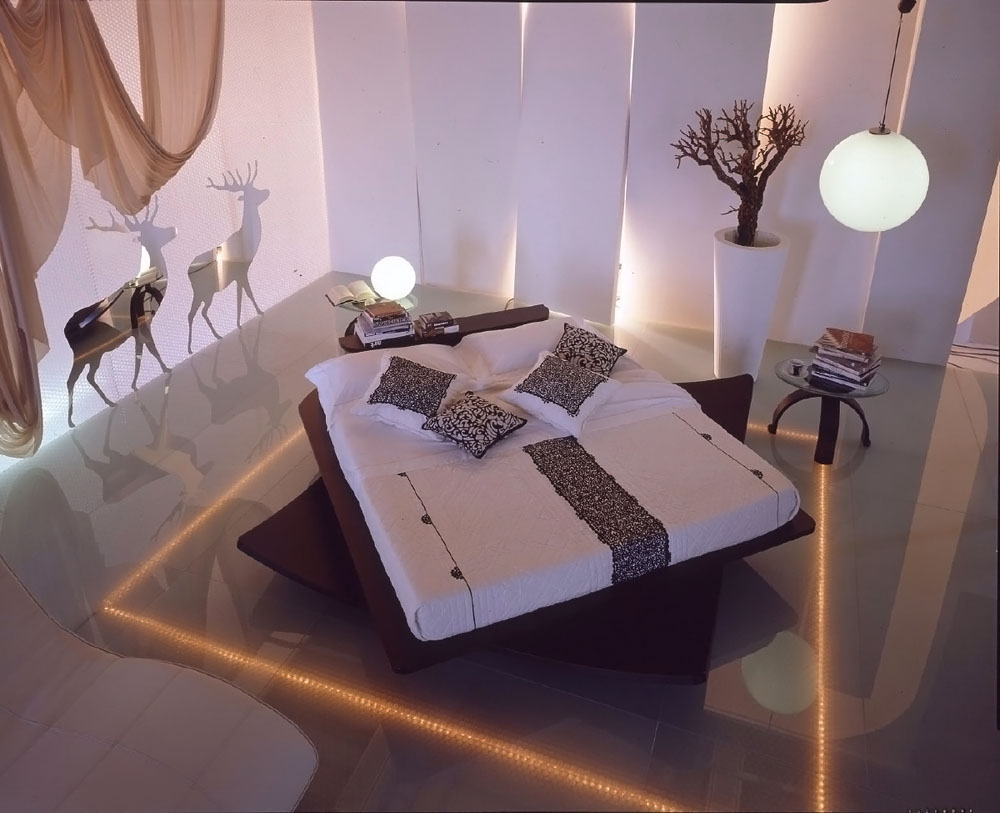
These qualities unite all LED devices, but there are differences between the products that relate to the base option, case dimensions and equipment power.
The device and circuits of LED lamps
Knowledge of the device will give an understanding of how to choose LED lamps for the home. The design consists of three main elements:
- the LED is considered a source of radiation, this element can have a different layout;
- mini transformer is engaged in voltage conversion;
- The radiator helps cool the heating transformer.

In addition, the device includes a diffuser used to distribute light. This element is made of polycarbonate or translucent plastic. The capacitor serves to remove the ripple in the voltage. Such a detail as a driver is used for alternating current.

An important detail is the brass base, which is responsible for contact with the cartridge and the base of the base, which protects the body from electricity breakdowns.
How to choose LED lamps for your home: an analysis of lighting devices
These light sources are more expensive than analogues. When deciding how to choose an LED lamp for your home, you need to analyze it for comparison with alternative fixtures. This will allow you to judge the effectiveness of LED devices.
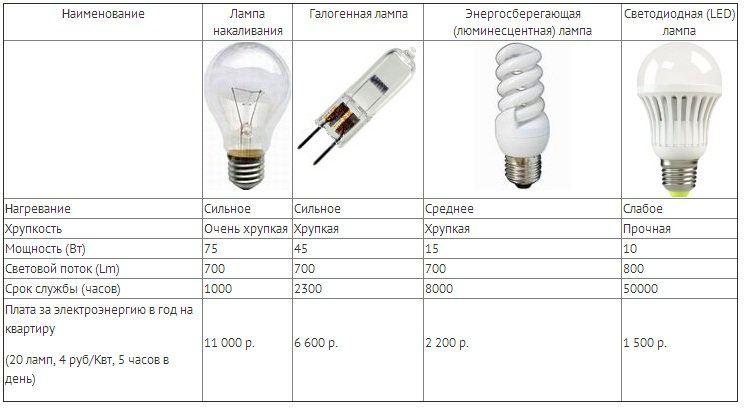
Related article:
Such lamps can save thousands of rubles a year. In this review, we will look at their types, characteristics and prices so that you can understand which ones are best suited for your tasks.
Plinth types
LED products are produced with different variations of standard socles. There are the following options:
- E 27 and 14 are common products. With a diameter of 14, elongated variants are used, as well as for floor lamps and sconces;
- GU 10 is a swivel base with two-pin connector. Apply in built-in type;
- GU 5.3 with 5.3 mm pin spacing. Used for spot lighting in drywall constructions;
- G 13 is used for ceiling and linear lighting fixtures for rooms with a large area.

When selecting structures according to the type of base, you need to choose those that are already installed in the house.
Table of power of LED lamps and incandescent lamps
Using the power table of LED lamps, you can evaluate the difference between this indicator and other light sources. It should be borne in mind that in the case of such models, power does not always indicate the brightness of the glow.
In the table you can see the power ratio of LED lamps and their analogues.
Table 1. Power ratio for LED lamps and their analogues
Light output indicators
An important indicator is the indicator luminous flux, which is measured in lumens. Not all manufacturers indicate this value, so many choose products based on power.
When organizing lighting in a home, it is worth choosing models with a power of 6-10 watts. Such products will provide a luminous flux, which is equal in brightness to incandescent lamps with a power of 60 watts.
Table 2. Luminous flux indicators for LED lamps and their analogues
| Fluorescent lamps | Incandescent paws | LED bulbs | |||
|---|---|---|---|---|---|
| Power, W | Luminous flux, lm | Power, W | Luminous flux, lm | Power, W | Luminous flux, lm |
| 5 | 145 | 15 | 135 | 3 | 360 |
| 11 | 500 | 60 | 730 | 6 | 630 |
| 21 | 900 | 100 | 1380 | 10 | 920 |

Color temperature features
Incandescent lamps at any power give a yellowish glow, and LED products can have different shades. When choosing LED lamps for a home with a base, you need to pay attention to the color of the glow. This parameter is indicated on the packaging of the lamps or in the technical documentation.
Helpful information! For decorating a living room, it is better to choose options with a neutral white glow.
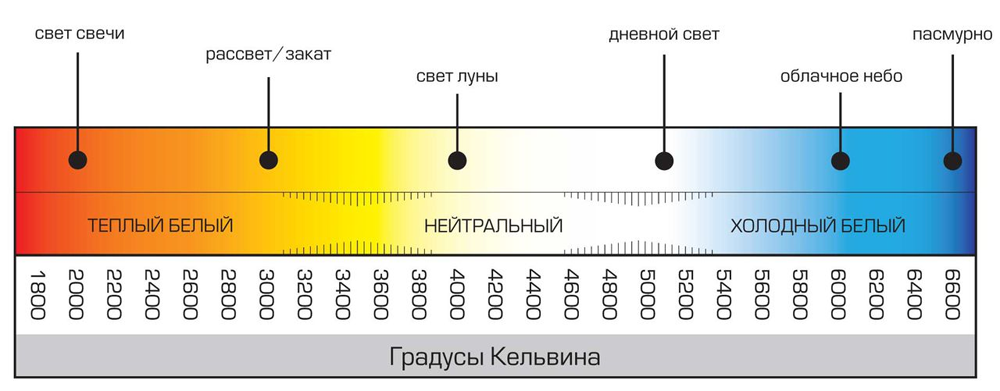
Angle of emission of light sources
Unlike conventional incandescent lamps, the angle of the luminous flux for such products may vary. This must be taken into account when choosing products. If you use products with a narrow stream, then a certain place on the ceiling will be illuminated. The manufacturer indicates the angle of dispersion on the package. For this, special technical designations are used. For example, VNSP stands for narrow beam, FL for low beam, and VWFL for wide beam.
Helpful information! Llamas with a narrowly focused glow are suitable for highlighting interior items.
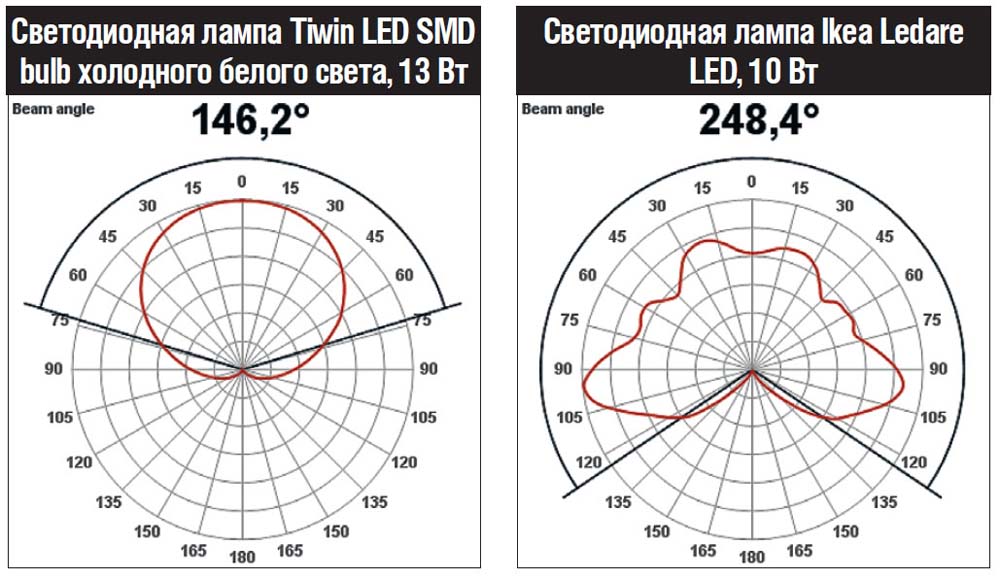
Illumination standards and the choice of model for the student's table
It is important to choose the right lighting for the student's desktop. In this case, you need to take into account the location of the lighting fixture, the table, and also choose the right model.

There are certain standards for desktop illumination. In this case, the light flux should be soft, even and not flickering. In addition to artificial lighting, it is important to use the main light. This will help to avoid fatigue and eye strain.
When choosing a model, you need to be guided by the safety and ease of use of the device. Many devices are equipped with a special holder. The plafond must completely cover the lamp so that the light does not enter the eyes.

Helpful information! On sale there are models of LED lamps that have.
Options for LED lamps for the home: prices
The table shows prices for some popular models.
Table 3. Average cost of LED lamps



